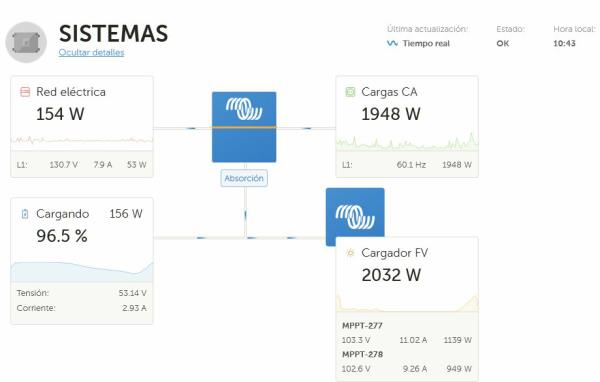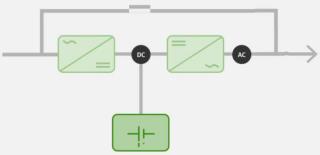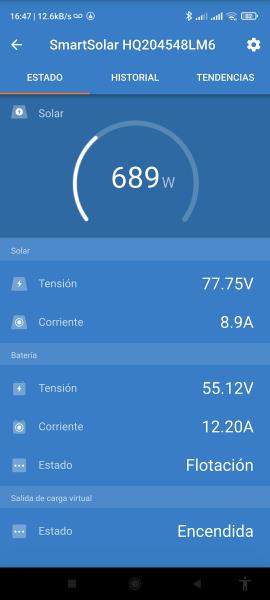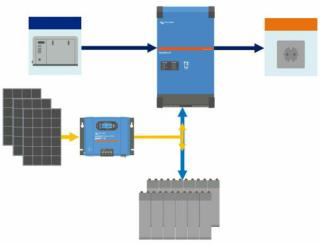Blackouts Solutions Backup Systems UPS Solar Energy
Across today’s highly connected and data-driven business landscape, the need for continuous, clean power cannot be overstated. Even the briefest amount of downtime can be devastating to an organization, regardless of its size or vertical. Not only is the current price tag for downtime estimated at $5,600 per minute, but unplanned incidents can result in equipment damage, data loss, missed opportunities and tarnished reputation.
Thankfully, an uninterruptible power system (UPS) is one of the most simple, cost-effective solutions to help companies avoid the unwelcome consequences of downtime. But with several different types of systems available, the challenge is selecting the one that best matches your needs and budget.
El sol es nuestro aliado
Inversores - UPS para energía solar
CODESOLAR
ENERGIA
S. A.
ESN
- Rectifier / Charger: It is in charge of converting the Alternating Current electricity, which arrives through the grid, into Direct Current, either to charge the batteries or to feed the inverter
.
- Batteries: They provide the electrical energy necessary to power the system in the event of a power outage.
- Inverter: This is an element that converts the electricity—coming either from the rectifier or from batteries—from Direct Current into Alternating Current, to be distributed to the systems connected to the UPS.
Uninterruptible power system UPS
Grid
Charger
Inverter
Battery
Backup Systems UPS Blackouts Solar Energy
CodeSolarEnergia S. A. Comunicacion Desarrollo Tecnologia Energia Solar
Quito, Ecuador, Sudamerica
How Does a UPS Work?
Essentially a battery in a box, a UPS powers the devices that are plugged in to its AC outlets when the flow of electricity drops to an inadequate voltage, or if a complete outage occurs. In case of a blackout, the UPS immediately switches to battery to provide a continuous power source for the length of the battery, which varies by system for periods of time ranging from minutes to hours.
Depending on the size and technology of the unit, a UPS is capable of protecting a single computer up to an entire data center. Essential for mission-critical environments, a UPS keeps computer systems and IT equipment safe and operational during a power loss until generators can be activated or protected devices such as servers and network components can be properly shut down, preventing loss of data and work-in-progress. In addition to delivering backup power during a utility failure, UPSs also afford varying degrees of protection against other damaging power problems, including voltage sags, surges, brownouts, line noise, frequency variations, overvoltage conditions, and switching transients and harmonic distortion.
What Is a UPS?
A UPS is a backup system that provides power in the event of a utility failure. By supplying an adequate window to safely shut down sensitive equipment, a UPS helps prevent data loss and minimizes the stress of a hard shutdown on electronics. But protecting equipment against a complete power loss isn’t the only reason you need a UPS. Depending on the UPS model, these systems also shield connected devices from common power problems and unsafe output voltage fluctuations that can damage electronics, reduce lifespan and affect performance.
Sistema respaldo Cargador - Batería - Inversor
Estos sistemas son más versátiles porque se puede dimensionar cada equipo o componente en el tamaño exacto para sus necesidades. Las baterías pueden ser dimensionadas para tiempos de apagones mayores de los apagones, y entonces sus refrigeradoras y congeladoras siguen funcionando sin interrupción, y en forma automática.
En casos de negocios, tiene luz, WiFi, facturación electrónica, etc. sin interrupción.
Por la posibilidad de dimensionar las baterías y los cargadores - inversores para su consumo, estos sistemas son una alternativa mejor que equipos UPS.
xxxxxxxxxxxxxxxx
xxxxxxxxxxxxxxxx
How long does a UPS last without power?
The battery power will last for a certain amount of time, depending on the size of the battery and the load that is being drawn from it. Typically, a UPS with internal batteries can last for around 5-10 minutes on its battery power.
Once the mains power has returned or stabilised, the UPS will automatically switch back to using AC power and then recharge the battery.
Sistema respaldo Cargador - Batería - Inversor

Seguimiento y control a distancia Victron Remote Monitoring VRM GX






